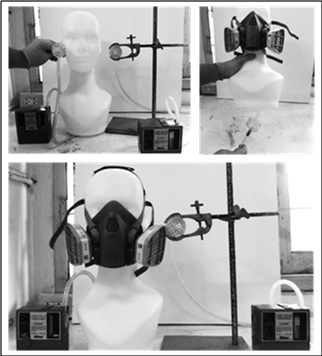Risk Assessment and Protective Effect of Respirators on Airborne Paraquat Exposure during Simulated Spraying Operations
DOI:
https://doi.org/10.48048/tis.2021.498Keywords:
Risk assessment, Airborne paraquat, Cartridge respirator, Testing chamberAbstract
Paraquat (PQ) is widely used as a herbicide in Thailand. The aim of this study was to evaluate the health risk and protective effect of respirators during simulated PQ spraying operations in an experimental chamber. Additional data were collected from the interviews of PQ sprayers. Airborne PQ concentrations were collected from an experimental spray chamber employing controlled-rate sprayers of solutions (paraquat dichloride in water) and were lower than 50 µg/m3 (the standard regulation). Air sampling through a polytetrafluoroethylene filter membrane was performed under the conditional settings of inside and outside respirators, and analysed by using a HPLC-UV detector following NIOSH method 5003. The average PQ concentrations inside the certified respirators (cartridge, cup-shaped mask, surgical mask) were significantly lower than those outside of the respirators (4.30 ± 2.63 µg/m3 vs. 19.12 ± 16.65 µg/m3), which was not found with convenient sponge masks. Human health risk assessment on short-term and long-term exposure following US.EPA guide estimation showed that cartridge respirators and cup-shaped masks significantly decreased the risk (hazard quotient) of adverse health effects (p-value < 0.05) among the PQ sprayers. As a result, the PQ sprayers should be aware of preventive action and use a qualified mask/respirator to protect against exposure to airborne PQ and chronic health effects.
HIGHLIGHTS
- The estimated human health risk from paraquat (PQ) exposure lower than the occupational exposure limit (OEL: 50 µg/m3) during the spraying operation was unacceptable for some sprayers
- The average PQ concentrations inside the certified respirators (cartridge respirator and cup-shaped mask) were significantly lower than outside of the respirators that was not seen with the convenient sponge mask, a common type used by the sprayers
- The cartridge respirator and cup-shaped mask significantly decreased the risk estimation of the PQ sprayers with regard to adverse health effects both from short-term and long-term PQ exposure
- It is important for preventive action on exposure to PQ of the sprayers by the use of qualified respirators or masks to protect against inhalation of PQ and decrease health risks
GRAPHICAL ABSTRACT
Downloads
Metrics
References
MM Morshed, D Omar, R Mohamad, S Wahed and MA Rahman. Airborne paraquat measurement and its exposure to spray operators. Int. J. Agric. Biol. 2010; 12, 679-84.
National Institute for Occupational Safety and Health (NIOSH) Recommended Exposure Limits (RELs) from the NIOSH Pocket Guide to Chemical Hazards, Available at: https://www.cdc.gov/niosh/npg, accessed April 2020.
GZ Fortenberry, J Beckman, A Schwartz, JB Prado, LS Graham, S Higgins, et al. Magnitude and characteristics of acute paraquat and diquat related illnesses in the US: 1998-2013. Environ. Res. 2016; 146, 191-9.
H Kumar, VB Singh, BL Meena, S Gaur and R Singla. Paraquat poisoning: A case report. J. Clindiagn Res. 2016; 2, 10-1.
VS Patil and GV Patil. A study of paraquat poisoning. Int. J. Sci. Res. 2016; 3, 118-21.
C Chakkhonburi ana S Chaiklieng. Health risk assessment on paraquat exposure of knapsack sprayers. Saf. Environ. Rev. 2017; 1, 23-30.
P Phetphung. Health effects of paraquat use and risk management at Pongsanuk Sub-district, Wiangsa district, Nan province (in Thai). Thai J. Pharm. Pract. 2015; 2, 250-8.
Department of agriculture. Report of hazardous substance import in Thailand 2019, Available at: http://www.doa.go.th/ard/?page_id=386, accessed May 2020.
Ministry of public health of Thailand. Health data center, Available at: https://hdcservice.moph.go.th/hdc/main/index_ pk.php, accessed May 2020.
S Chaiklieng and S Nonkratoke. Risk assessment on pesticide exposure by biological monitoring among farmers: A case study in Tambon Kangsanamnang, Nakhonratchasima Province. Srinagarind Med J. 2013; 3, 382-9.
S Chaiklieng. Toxicology in public health. Khon Kaen University Printing, Khon Kaen, Thailand, 2014.
American Conference of Governmental Industrial Hygienists. TLVs and BEIs. United State, 2019.
Department of Labor Protection and Welfare issued in concentration limit of chemical hazard at workplace, Available at: http://www.ratchakitcha.soc.go.th/RKJ/announce/search_result.jsp?SID= 55E6506DD21DCFE93B7675E8F1417CC5, accessed May 2020.
National Institute of Occupational Safety and Health. NIOSH manual of analytical methods (NMAM), Available at: https://www.cdc.gov/niosh/docs/2003-154/pdfs/5003.pdf, accessed April 2020.
US.EPA. Risk assessment guidance for superfund volume I: Human health evaluation manual supplemental guidance “Standard default exposure factors” interim final. US.EPA, United State: Washington DC, 1991.
European commission. Paraquat, 2003, Available at: http://ec.europa.eu/food/plant/pesticides/eu-pesticides-database/public/?event=activesubstance.detail&language=EN&selectedID=1669, accessed May 2020.
Integrated Risk Information System (IRIS): United States Environmental Protection Agency. Paraqua, Available at: https://cfpub.epa.gov/ncea/iris2/chemicallanding.cfm?substance_nmbr=183, accessed April 2020.
California Division of Occupational Safety and Health (Cal/OSHA) Permissible Exposure Limits (PELs) from Table AC-1 last viewed October 2, 2019, Available at http://www.dir.ca.gov/title8/5155table_ac1.html, accessed April 2020.
Q Xu, X Wang, Q Wu, X Jian, B Kan, B Gao and K Wang. Urinary paraquat concentration and white blood cell count as prognostic factors in paraquat poisoning. Trop. J. Pharmaceut. Res. 2018; 17, 1391-6.
P Konthonbut, P Kongtip, N Nankongnab, M Tipayamongkholgul, W Yoosook and S Woskie. Paraquat exposure of backpack sprayers in agricultural area in Thailand. Hum. Ecol. Risk Assess. Int. J. 2020; 10, 2798-811.
Downloads
Published
How to Cite
Issue
Section
License

This work is licensed under a Creative Commons Attribution-NonCommercial-NoDerivatives 4.0 International License.







